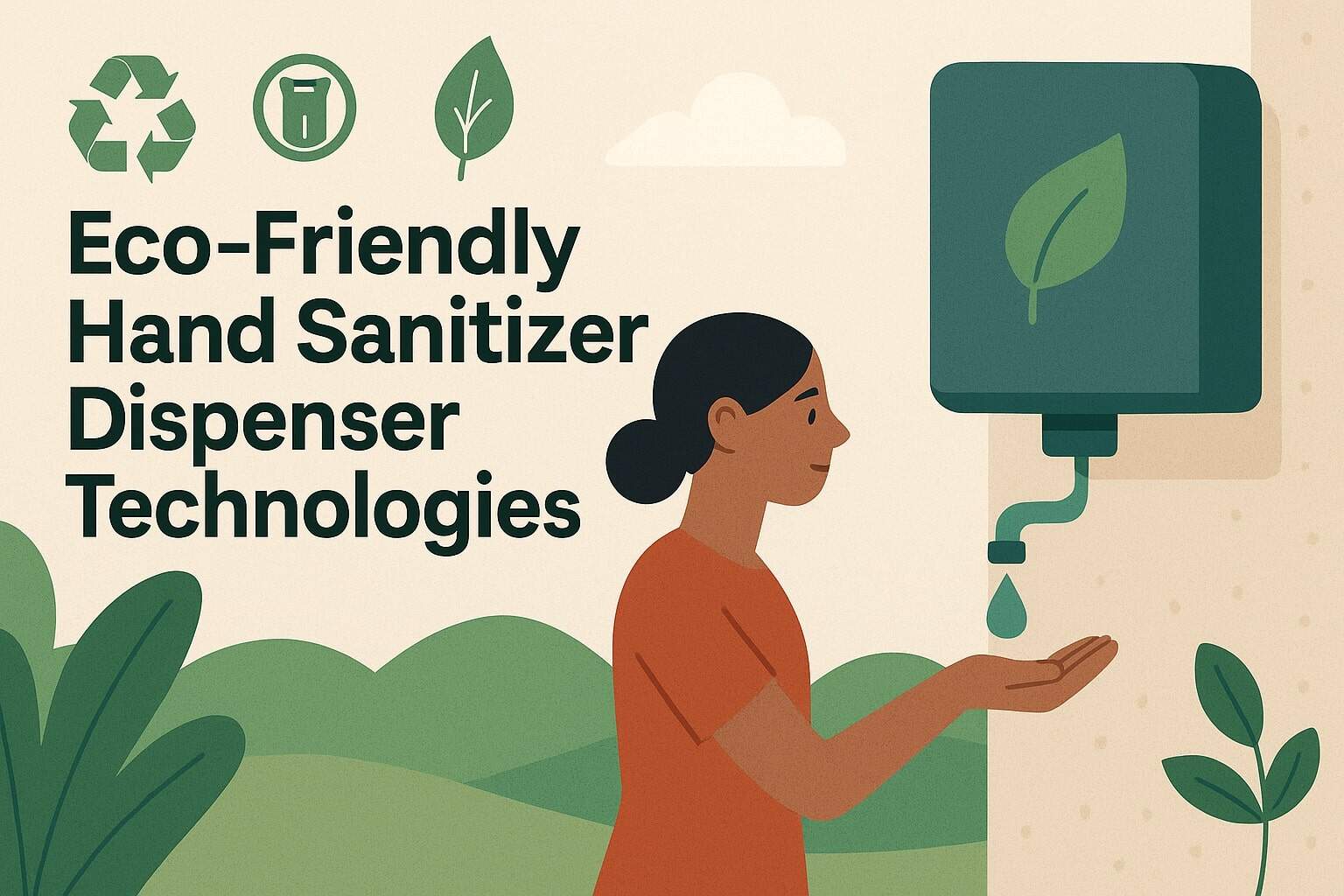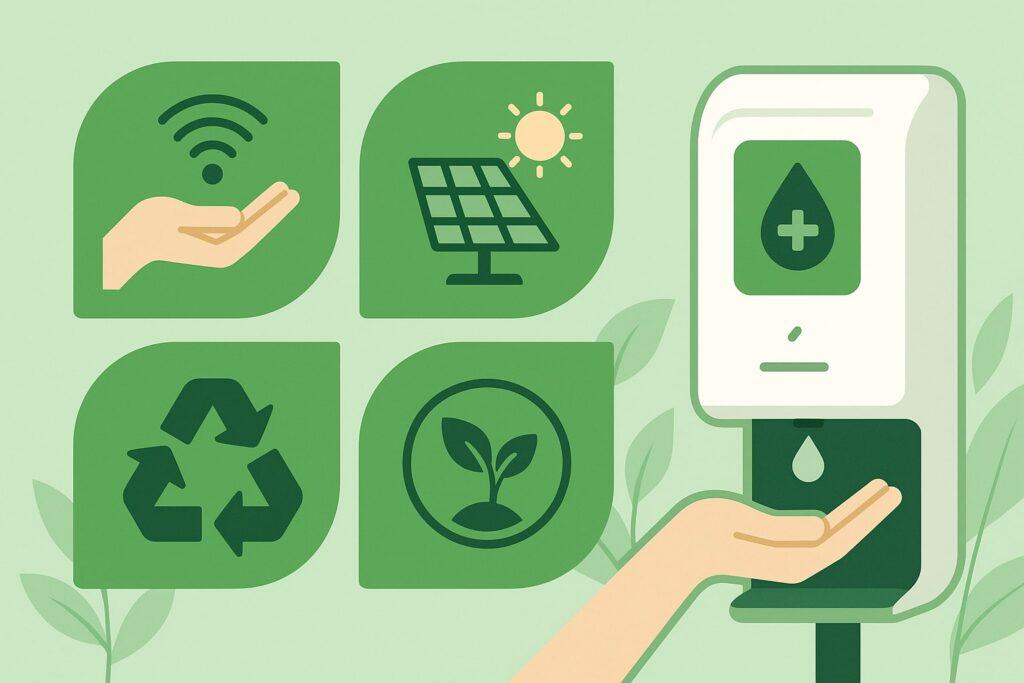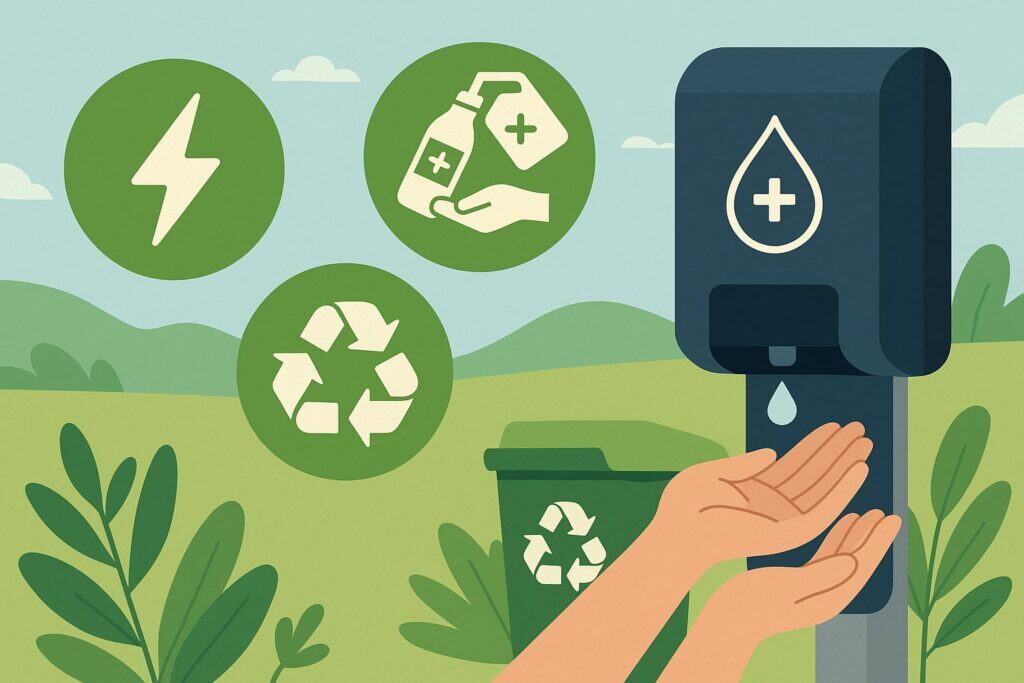
By myhandsanitizershop October 16, 2025
Eco-friendly hand sanitizer dispenser technologies combine touchless hardware, efficient dosing, and sustainable materials to deliver hygiene with a smaller environmental footprint.
These systems cut plastic waste, save energy, and optimize sanitizer use without sacrificing safety or user experience. In a world where public health and sustainability now go hand in hand, the right dispenser can reduce operational costs and environmental impact at the same time.
Most modern devices emphasize closed-loop refills, modular parts, and long-lasting power sources. Durable housings made from recycled plastics or aluminum extend product life.
Smart flow restrictors and calibrated pump heads prevent over-dispensing that would otherwise increase waste. Many units also support high-viscosity gels and low-viscosity liquids, allowing facilities to choose EPA-listed products that meet their infection control standards while staying green.
Eco-friendly hand sanitizer dispenser technologies also consider the full lifecycle. Manufacturers now publish reparability scores, offer extended parts availability, and design cartons that ship flat to reduce transport emissions.
The goal is to minimize emissions from raw materials through end-of-life. For U.S. buyers, this means lower total cost of ownership, better compliance alignment, and measurable sustainability gains. The result is a dispenser strategy that is cleaner for hands and cleaner for the planet.
Why They Matter for U.S. Businesses
For U.S. employers, the right dispensers help check three boxes: employee safety, regulatory alignment, and ESG progress. Touchless systems support safer shared spaces in offices, retail, healthcare, schools, and hospitality.
When paired with CDC-aligned sanitizer formulations, they help reduce pathogen transmission risks in high-traffic areas like lobbies, break rooms, and restrooms.
From a compliance perspective, eco-friendly hand sanitizer dispenser technologies make ADA mounting, accessibility, and placement easier to standardize.
Units with consistent output volumes help safety teams document usage assumptions for risk assessments. Refillable, lockable reservoirs deter tampering and theft, while transparent tanks simplify visual inspections for custodial teams on tight schedules.
Finally, these technologies create trackable sustainability wins. Right-size dosing reduces per-capita sanitizer consumption. Bulk refill programs slash single-use plastics. Long-life batteries and optional solar trickle charging decrease maintenance trips and battery waste.
For companies reporting on emissions and waste reduction, dispensers are a small but visible proof point that supports broader sustainability narratives across facilities and environmental reports in the U.S. market.
Core Technologies and Materials

At the heart of eco-friendly hand sanitizer dispenser technologies are smart mechanics and responsible materials.
Touchless infrared or time-of-flight sensors activate the pump without contact, cutting surface contamination. Internal microcontrollers regulate dosing with each activation, delivering consistent volumes across gel, liquid, or foam. Precision matters: too much sanitizer drives cost and waste, too little reduces efficacy and trust.
Sustainable housings are increasingly made from post-consumer recycled (PCR) plastic or powder-coated aluminum. These materials balance durability with lower embodied carbon.
Windowed reservoirs allow quick level checks to prevent run-dry situations that frustrate users. Lockable lids deter contamination and support safety in sensitive environments such as clinics, groceries, and quick-serve restaurants.
Pump assemblies have evolved too. Peristaltic designs avoid valves that can clog with gel, while high-tension springs and chemically resistant seals maintain performance across alcohol concentrations.
Units designed for modularity make field repairs simple, extending service life. Taken together, these components make eco-friendly hand sanitizer dispenser technologies dependable, maintainable, and aligned with sustainability goals from the start.
Sensor Systems and Dosing Algorithms
Modern sensor stacks in eco-friendly hand sanitizer dispenser technologies use narrow-beam IR or laser-based time-of-flight to detect hands reliably in bright lobbies, daylight near windows, or dim corridors.
Firmware filters out false triggers from reflections and passing objects. Adjustable detection ranges let you tailor responsiveness for crowded entrances versus quiet offices.
Dosing algorithms control how much sanitizer is dispensed and how quickly the pump can be re-triggered. Facilities can set small, medium, or large doses based on product viscosity, user feedback, and CDC hand rub guidance.
Anti-hammer logic prevents rapid re-activations of waste products. Some premium devices log dispenses and battery voltage, enabling data-driven maintenance and ordering.
Safety features include soft-start motors that reduce wear and noise, and stall detection that pauses the pump when gel is too thick. Error indicators and blinking LEDs help custodians diagnose empty reservoirs or low batteries at a glance.
By pairing precise sensors with robust firmware, these dispensers deliver predictable output and smoother on-site operations—key traits for U.S. facilities with diverse traffic patterns and staffing.
Power, Refills, and Waste Reduction

Power efficiency is a defining trait of eco-friendly hand sanitizer dispenser technologies. High-capacity rechargeable batteries can support months of use per charge, depending on traffic and dose size.
Some wall-mounted units accept DC adapters for continuous power where outlets are available. Smart sleep modes, low-draw microcontrollers, and efficient pumps further extend battery life and reduce maintenance trips.
Refill strategies have the biggest impact on waste. Bulk refill reservoirs eliminate the constant churn of single-use cartridges. Look for wide-mouth, spill-resistant tanks that accept funnel fill or quick-connect systems to speed service.
Foam pumps paired with aerators can cut sanitizer consumption per use while maintaining coverage and user satisfaction.
Waste reduction also extends to packaging and logistics. Concentrated refill formats reduce freight emissions and storage space. Manufacturers that offer take-back programs for worn parts and batteries keep materials in circulation.
When measured over a year of use in a busy lobby, these small design decisions add up, making eco-friendly hand sanitizer dispenser technologies a practical lever for sustainability outcomes.
Energy Options—Rechargeable, Solar, and Kinetic
U.S. facilities have multiple power profiles. Rechargeable Li-ion or LiFePO₄ packs provide stable voltage and long cycle life with integrated battery management systems.
For exterior entries and sun-lit atriums, small solar panels can trickle-charge batteries, cutting ladder time and disposable battery waste. In low-light interiors, high-efficiency electronics still stretch months between charges.
Some experimental models harness kinetic energy from mechanical presses, generating power as users interact. While not yet as common, this approach eliminates batteries entirely in certain manual-assist designs and aligns tightly with eco-friendly goals.
Regardless of the approach, choose units with clear battery indicators and accessible charging ports. Standardized battery formats simplify spares across a campus.
When evaluating eco-friendly hand sanitizer dispenser technologies, match power mode to traffic and lighting. High-traffic retail may favor DC-powered units to eliminate downtime. Museums and offices with moderate traffic can lean on rechargeable packs.
School districts with outdoor kiosks can pair solar with robust housings and vandal-resistant mounts. The right energy plan keeps dispensers online and maintenance predictable.
Standards, Safety, and Compliance in the U.S.

Compliance is critical for U.S. buyers. Dispenser placement should follow ADA reach ranges and protrusion limits so devices are accessible to all users.
Mounting heights, clear floor space, and hallway projections must be considered for wall-mounted and freestanding units. Clear labeling and intuitive icons help multilingual populations understand use quickly.
Pair dispensers with hand rubs that follow CDC’s guidance on alcohol content and application. In healthcare and food service, check that sanitizers are registered or listed as required and that Safety Data Sheets (SDS) are available for on-site review.
Facilities should also ensure compatibility between sanitizer formulations and pump materials to avoid swelling seals and leaks.
Fire codes matter too. Alcohol-based sanitizer is a flammable liquid and storage limits may apply, especially in schools, hospitals, and assembly occupancies. Keep refills in compliant cabinets where required, and follow local guidance on maximum container sizes.
Eco-friendly hand sanitizer dispenser technologies help here by optimizing output, reducing unnecessary refills, and incorporating robust spill-prevention features.
ADA, OSHA, CDC, and EPA Considerations
Eco-friendly hand sanitizer dispenser technologies intersect with multiple U.S. agencies and standards. ADA guidelines inform how high to mount units, how far they can extend into a corridor, and how easily they can be operated with one hand without tight grasping.
OSHA programs emphasize hazard communication, PPE for custodians handling bulk refills, and clear labeling for alcohol-based products.
CDC guidance underpins product selection and use patterns, including proper alcohol percentages and hand rub technique signage.
EPA relevance appears when considering environmentally preferable purchasing, VOC limits for certain formulations, and end-of-life disposal for electronics and batteries. Following these frameworks ensures hygiene programs are not only sustainable but also safe and equitable.
Document your program. Keep a site plan showing dispenser locations, refill types, SDS folders, and maintenance intervals. Train staff on safe refill handling and spill cleanup.
When eco-friendly hand sanitizer dispenser technologies are implemented with a documented compliance plan, audits go faster, user trust increases, and sustainability is backed by strong governance.
Deployment, Maintenance, and Total Cost of Ownership
Strong deployment plans start with a traffic study. Count peak and average entries for each door or corridor. Select dose sizes based on product viscosity and desired hand coverage.
Place units where users naturally pause—outside elevators, near cafeterias, and at classroom doors—to maximize adoption. Freestanding pedestals help in open spaces, while wall mounts save floor area.
Maintenance is where eco-friendly hand sanitizer dispenser technologies shine. Larger reservoirs and bulk refills mean fewer service rounds.
Clear sight windows and low-level alerts reduce “empty” incidents that erode confidence. Standardized keys and parts across models keep toolkits small. Keep spare pumps and seals on hand to minimize downtime in busy seasons.
Total cost of ownership (TCO) includes the device, mounting hardware, power, refills, labor, and end-of-life. Waste-saving features—foam aeration, precise dosing, and lockable reservoirs—pay back quickly in high-traffic sites.
Over three years, reduced plastic waste, fewer battery swaps, and longer service intervals often outweigh slightly higher upfront costs. That is the practical business case for sustainable dispensers in the U.S.
Data, IoT, and Facility Integration
Connected options push efficiency further. Some eco-friendly hand sanitizer dispenser technologies use low-power Bluetooth or LoRaWAN to report levels, battery status, and activation counts.
Dashboards consolidate locations across campuses, helping supervisors route staff only where needed. QR codes on each unit can link to mobile checklists, SDS sheets, and refill SKUs to streamline service.
Integration with existing facility platforms—like work order systems or building management software—turns hygiene into a predictable workflow. Alerts can trigger tickets when reservoirs drop below thresholds or when batteries approach end-of-life.
Traffic analytics derived from activation counts can inform staffing, signage, and even HVAC strategies near entrances.
Privacy-safe analytics respect user anonymity while still delivering operational insights. For U.S. organizations wary of network complexity, a hybrid approach works: start with non-connected eco-friendly hand sanitizer dispenser technologies in low-traffic areas and deploy connected models where data adds the most value, like stadiums, airports, and hospitals.
Buying Guide and Vendor Checklist
Start with requirements. Define locations, expected daily activations, refill preferences, and power availability. Shortlist models that support your chosen sanitizer formulation and viscosity.
Ask for independent durability testing, chemical compatibility data, and mean time between failures. Request a sample unit to test mounting, dosing, and refill workflow with your custodial team.
Then compare sustainability features. Look for recycled content in housings, modular repair design, and availability of spare parts for at least five years.
Evaluate whether the vendor offers take-back programs for dead batteries and worn pumps. Scrutinize packaging: flat-pack pedestals and concentrated refills reduce freight emissions and storage costs.
Finally, examine support and documentation. Eco-friendly hand sanitizer dispenser technologies should ship with clear installation guides, ADA-aware placement diagrams, SDS templates, and warranty terms.
A good vendor will provide training videos, virtual walkthroughs, and fast access to replacement parts. Choose partners with U.S.-based service channels and predictable lead times so your hygiene program stays resilient year-round.
Warranty, Certifications, and Contracts
Warranty terms are a window into product quality. Favor multi-year coverage on motors, sensors, and structural parts.
Check exclusions related to non-approved sanitizer formulations, and confirm the warranty remains valid with bulk refill usage if that’s your plan. Service-level agreements (SLAs) for parts shipping and technical support keep downtime low.
Certifications matter too. Look for declarations on recycled content, RoHS compliance for electronics, and any third-party sustainability labels that align with your corporate purchasing standards.
For connected models, review cybersecurity basics: encrypted communications, configurable update policies, and a clear privacy stance on collected telemetry.
Contract structures should support scaling. Price locks for refills, volume discounts, and pilot-to-rollout programs reduce risk. Clauses for end-of-life take-back and responsible recycling ensure the eco-friendly promise extends beyond day-to-day use.
With strong warranties and transparent certifications, eco-friendly hand sanitizer dispenser technologies deliver durable value to U.S. organizations.
FAQs
Q.1: Are eco-friendly dispensers more expensive than standard models?
Answer: Upfront, eco-friendly hand sanitizer dispenser technologies can cost slightly more due to durable housings, higher-efficiency pumps, and better sensors. However, long-term math typically favors sustainability.
Precise dosing reduces sanitizer spend. Bulk refill reservoirs cut single-use cartridges and associated freight. Rechargeable power or DC adapters eliminate hundreds of disposable batteries over a product’s life.
Labor savings are real. Larger tanks and status windows reduce “just-in-case” checks. Connected options route staff only when levels are low. Longer service intervals mean fewer interruptions in busy retail or healthcare settings.
Over a three-year horizon, these savings often offset the initial premium and then some. In short, eco-friendly hand sanitizer dispenser technologies are an investment that pays back through lower waste, lower labor, and higher uptime.
Q.2: Do touchless dispensers actually reduce transmission versus manual pump bottles?
Answer: Touchless eco-friendly hand sanitizer dispenser technologies reduce the need to touch a shared surface before sanitizing, cutting a potential contamination step.
While no device can replace proper hand hygiene technique, sensors that trigger reliably with consistent doses improve user confidence and encourage frequent use in high-traffic areas.
The biggest advantage is behavioral. When dispensers feel clean and respond instantly, more people use them. Consistent dosing means users get enough product to rub thoroughly.
Paired with visible placement and instructional signage, touchless systems help create a culture of hygiene. That culture, plus good sanitizer selection and cleaning protocols, supports lower transmission risk in workplaces, schools, and public spaces.
Q.3: Can I use bulk refills without voiding the warranty?
Answer: Many eco-friendly hand sanitizer dispenser technologies are engineered for bulk refills, but you should confirm compatibility. Check viscosity ranges, alcohol content tolerance, and any approved product lists.
Using a formulation outside the device’s spec can swell seals, clog pumps, or degrade hoses, which might void coverage.
Choose lockable, wide-mouth reservoirs for safer refill handling. Train staff to label containers, wear appropriate PPE, and record lot numbers where required.
If your organization prioritizes EPA-listed or specific healthcare-grade formulations, ask vendors for chemical compatibility statements in writing. With the right pairing, bulk refills deliver lower cost, less waste, and full warranty protection.
Q.4: How do I calculate the carbon footprint reduction from switching?
Answer: Start with a baseline. Measure current sanitizer consumption per month, number of cartridges or bottles used, battery replacements, and maintenance trips.
Then model your eco-friendly hand sanitizer dispenser technologies with precise dosing, bulk refills, and rechargeable or DC power. Include packaging weights, shipping frequency, and expected device lifespan.
Use emission factors for plastics, carton materials, last-mile delivery, and battery disposal. Many organizations convert fuel use for maintenance runs into CO₂-equivalents. The delta between old and new programs reveals your reduction.
Even modest improvements in dosing and packaging can yield significant annual savings across a multi-site U.S. footprint. Document assumptions and update quarterly to show continuous improvement.
Q.5: What should schools, healthcare, and food service consider?
Answer: Each vertical has specific needs. Schools benefit from rugged housings, tamper-resistant locks, and visual level windows so staff can spot empties quickly.
Healthcare requires compatibility with approved hand rubs, clear SDS access, and secure mounting to prevent tip-overs. Food service prioritizes splash resistance, easy-clean surfaces, and dispensers placed before production zones and dining areas.
Across all three, eco-friendly hand sanitizer dispenser technologies help by reducing plastic waste and service time, two constraints that hit public budgets hard. Standardize models to simplify spares and training.
Choose power modes that fit the environment—DC in busy cafeterias, rechargeable in classrooms, solar-assist at stadium gates. With thoughtful selection, each sector can improve hygiene and sustainability together.
Conclusion
Eco-friendly hand sanitizer dispenser technologies bring hygiene, sustainability, and smart operations into the same plan. Touchless sensors and calibrated dosing protect users while reducing waste. Refillable reservoirs and concentrated supply chains cut plastics and freight emissions.
Rechargeable, solar-assist, or DC power trims maintenance and battery disposal. For U.S. organizations, the result is a safer, cleaner, and more cost-effective program that aligns with ADA, OSHA, CDC, and environmental expectations.
The path forward is straightforward. Map traffic, choose compatible formulations, and standardize models. Train staff on safe refills and simple diagnostics. Consider connected options where scale and visibility justify the upgrade.
Most importantly, measure outcomes—usage, waste, maintenance time, and carbon impacts—so you can prove the benefits and continuously improve.
By adopting eco-friendly hand sanitizer dispenser technologies today, your organization protects people, respects the planet, and builds a resilient hygiene program for the years ahead.